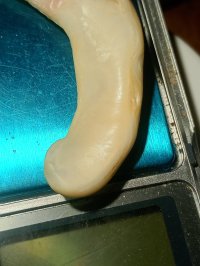"Hello community. I would like to point out that I do not know pearls, so please do not throw them under the bus. A few years ago, on a rocky stretch of beach in St Nazaire in western France, I found what I thought was a mother-of-pearl uterus or shell frequency. It was intentionally broken by a curious family member and has a layered structure. He thinks that after polishing and processing, it could be turned into something beautiful. Looking forward to checking"
Identification by species is not possible given the information provided.
These pieces present as molluskan in origin. Likely subclass Heterodonta. While technically they may be considered pearls, concretions might be the better description. Likely formed in the viscera or between a grossly sectioned/infected mantle.
The pieces are high in calcite, low on aragonite and nearly absent of contrasting proteins. Thus no gemological value other than folk art. Pearls of any type cannot be polished to improve luster and appearance.
For someone like me, these types interesting nonetheless. Often abberations of pearls have some scientific value, but without an anatomical context on the whole (in situ) there is not much more I can add.
It's quite alright to ask for help! We encourage questions greatly among this group. Thank you for sharing these images with us.
 am na Państwa opinia.
am na Państwa opinia.



 am na Państwa opinia.
am na Państwa opinia.
